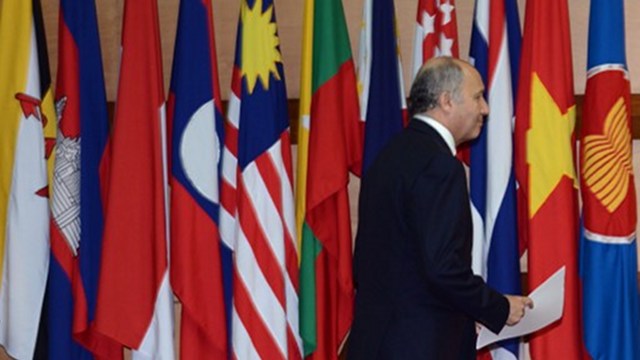SUMMARY
This is AI generated summarization, which may have errors. For context, always refer to the full article.

MANILA, Philippines – The Southeast Asia economic bloc will not adopt a single currency, like its counterpart in Europe, to preserve the competitiveness of the exports sector of each of the member economies.
This was stressed by Le Luong Minh, secretary-general of the Association of Southeast Asian Nations (Asean), at the MAP International CEO Conference in Makati City on Tuesday, September 10.
“That’s not the intention of Asean,” Minh said, stressing that it is not advisable, nor enforceable to have a single currency in Asean especially after the euro experience.
The crisis has shown that the euro, the common currency used by member states of the European Union, has reflected the weak economies’ problems, swiftly madding trouble for the stronger performers.
Considering that the yawning gap between the economies of Asean members — say, the very wealthy Singapore and least developed Cambodia — obstacles in the way of developing a single currency for Asean are stark, Minh noted.
He also said that the political systems and the levels of development of Asean members are varied, unlike the EU.
The expected benefits of having a single currency usually include lower transaction costs, reduced exchange risk, price stability, and to become one of the major currencies in the world.
However, when countries form a single currency, they give up the power of an independent monetary policy and can no longer use tools, like interest rates, to address cyclical needs of a country’s specific industries or financial services.
Instead of looking towards a single currency, Asean is focusing on its 2015 goal of economic integration, Minh said.
Integration
Minh said the goal of becoming a single market by the end of 2015 is on track. The Asean economic community (AEC) targets 90% to 95% rate of implementation of about 400 measures under the AEC blueprint.
Currently, rate of implementation is at 79.7%, up from 74.5% just 4 months ago.
Minh said a number of measures though have yet to be transformed into national plans of individual countries such as those pertaining to standards, transportation and single window. For the latter, only 7
countries have committed and 3 — Brunei, Myanmar and Lao PDR — have yet to go on board.
“Integration is a work in progress rather than an event that will continue beyond 2015,” Minh stressed.
Asean includes Brunei, Cambodia, Indonesia, Laos, Malaysia, Myanmar, the Philippines, Singapore, Thailand and Vietnam.
Minh cited the benefits of implementing those measures to less developed economies in the region, with their share in the GDP of entire Asean doubling to 12% from 6% prior to phasing in to those measures.
He added that the roadmap calls for leveling the gap of development of old members of Asean with the new members, Cambodia, Laos, Myanmar and Vietnam.
Fifteen areas, including education, capacity building and connectivity, have been identified as priority sectors where the older members would assist the new ones, Minh said.
He said that beyond AEC 2015, Asean moves to strengthen ties with other trading partners through thd regional comprehensive economic partnership that brings Asean together with countries of East Asia,
China, Japan and Korea as well as Australia, New Zealand and India. – Rappler.com
Add a comment
How does this make you feel?

![[ANALYSIS] How one company boosts farmer productivity inside the farm gate](https://www.rappler.com/tachyon/2024/06/bioprime-farmgate-farmer-productivity-boost.jpg?resize=257%2C257&crop=465px%2C0px%2C1080px%2C1080px)

![[In This Economy] Is the Philippines quietly getting richer?](https://www.rappler.com/tachyon/2024/04/20240426-Philippines-quietly-getting-richer.jpg?resize=257%2C257&crop=194px%2C0px%2C720px%2C720px)
![[In This Economy] Can the PH become an upper-middle income country within this lifetime?](https://www.rappler.com/tachyon/2024/04/tl-ph-upper-income-country-04052024.jpg?resize=257%2C257&crop=295px%2C0px%2C720px%2C720px)
![[EDITORIAL] Apat na taon na lang Ginoong Marcos, ‘di na puwede ang papetiks-petiks](https://www.rappler.com/tachyon/2024/07/animated-bongbong-marcos-2024-sona-day-carousel.jpg?resize=257%2C257&crop=280px%2C0px%2C720px%2C720px)
![[In This Economy] Delulunomics: Kailan magiging upper-middle income country ang Pilipinas?](https://www.rappler.com/tachyon/2024/07/in-this-economy-upper-middle-income-country.jpg?resize=257%2C257&crop=421px%2C0px%2C1080px%2C1080px)

![[EDITORIAL] Marcos Year 2: Hilong-talilong](https://www.rappler.com/tachyon/2024/07/animated-bongbong-marcos-2nd-sona-carousel.jpg?resize=257%2C257&crop=136px%2C0px%2C720px%2C720px)
![[Newspoint] A fighting presence](https://www.rappler.com/tachyon/2024/07/thought-leaders-a-fighting-presence.jpg?resize=257%2C257&crop=441px%2C0px%2C1080px%2C1080px)
There are no comments yet. Add your comment to start the conversation.